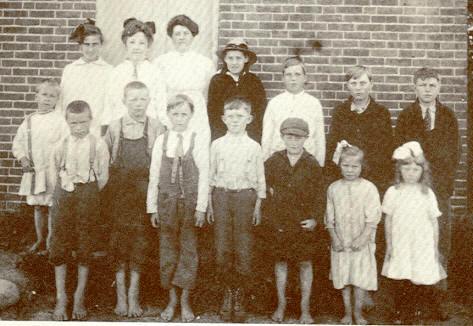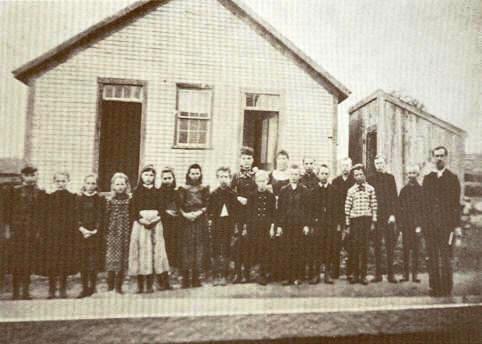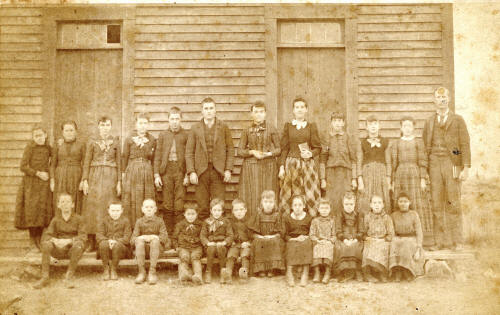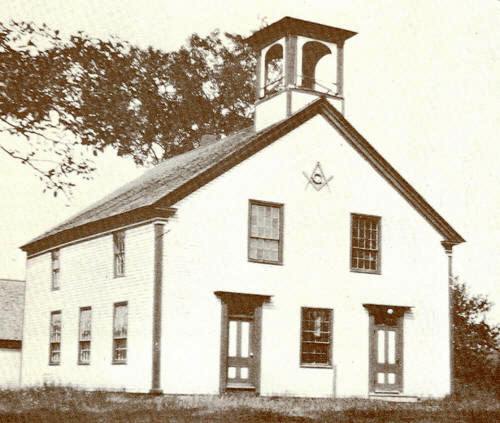|
Early Schools
|
|
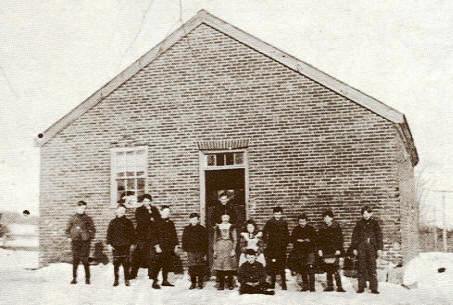 The Brick Or Longfellow School In District 12
|
For a long time the
intersection of the Libby, Hallowell and Plains Roads was called
Potters Corner and the area was designated School District 12.
The building was called the "Brick School" for most of its life.
The Central School, built near the old site in 1949, provided
elementary classrooms for the entire town until grades 7-9 were
assigned to the Academy building in 1960. The picture, taken about 1900, shows Rena (Ashford) Knight at the doorway in front of the teacher, Miles Dustin. Mrs. Knight, who later taught the school herself, remembers most of her schoolmates as follows. Mr. Dustin conveyed pupils from his Oak Hill neighborhood to the school in a covered cart - a forerunner of the school bus. These pupils included William and Leland Buker, Mr. Dustin's sons Clifton and Cecil and daughter Genevieve (fifth from right) and the "big boy", David Powers (third from left). From Pottertown came the two Verney boys, Lee and Walter, also Clyde Chase, Delmar Small, Willard Ashford and Edward Libby. source: Litchfield Yesterdays
|
| Although the Corner School
District numbered 62 scholars in 1869, enrollment had shrunk by 1925
to 14 pupils a term and school was kept in only seven other
districts in town. "It shocks us," the school committee had
observed some years earlier, "to have the old schoolhouses shut up
or sold. Our fathers and perhaps grandfathers attended school
in them and the old buildings seem a part of us." The three teachers at the Corner in 1925 - Irene Libby in spring, Della Tuttle in the fall and Charles Jones in the winter term averaged salaries of $17 a week. The town appropriated $4000 for common schools that year, Superintendent Cyrus M. Kendrick reported, and with balances and state aid the schools had $7973 in total resources. Of that amount $4544 went for teachers' salaries and $942 for conveyance. The contract with the Academy trustees for high school tuition required $1328. source: Litchfield Yesterdays |
 The Corner Or Lincoln School In District 1
|
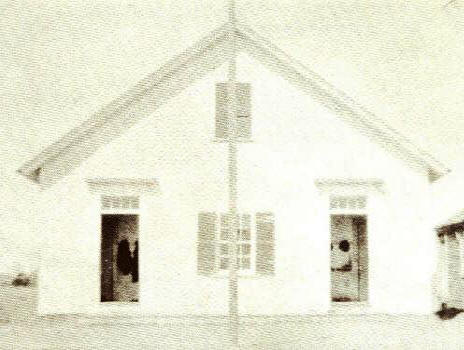 The North Or Willard School, District 6, Before 1910 |
In 1869 twenty-six scholars lived in the north District, and the town appropriated $3.09 per scholar - $80.34 in all - to be expended by Jacob True, agent, for operating the school. Emily Palmer taught the six-week summer session and Susan B. Stanchial the seven-week winter term. As early as 1788 a citizen taught in the log houses of the different families in Smithfield Plantation, taking his pay clearing land or in farm work. By 1803 there were ten members on the school committee, one from each district, and by 1806 there was a school building. It "had a door at one end and a great open fire at the other. The seats were on opposite sides of the room sloping toward the teacher at the center. When a pupil left his seat he must walk on the seats behind the other pupils." The name "Willard" was probably in honor of Frances E. Willard, 1839-1898, an author, educator and reformer who was one of America's notable women. Perhaps Litchfield girls attending the Willard School held their heads and hopes higher because of the example set by Frances Elizabeth. source: Litchfield Yesterdays
|
| The schoolhouse,
a brick building dating from 1842, stood where the ruins may still
be seen on the west side of the Stevenstown Road. Back in 1869 sixty-two scholars lived in District 9; the average school attendance was 27 that year. Samuel Williams, agent, hired Miss G. A. Wilson to teach the summer term and Tappan Hathaway the winter term. Around 1890 when the town organization replaced the district system a number of the old school names were discarded in favor of more highfalutin' literary or historical ones: Willard, Lowell, Whittier, Longfellow, Holmes, Washington and Grant. In 1900 only three of the nine schools open kept their former names: Corner, Ferrin and South Oak Hill. source: Litchfield Yesterdays |
The Stevenstown Or Whittier School, District 9, 1916 Back row, L. to R. - Theresa Bishop, Rena Bailey, Ethel Small Brann (teacher), Leona Weston, Frozell Belyea, Hebar Richardson, Philip T. Weston. Front row - George Bishop, Edward Weston, George Weston, Vernon Richardson, Clifton Brann, John Richardson, Dora Weston, Helen Stevens.
|
|
The Cook School At Pottertown In The 1890's Pupils, left to right: Angie (Roberts) Pierce, Edith (Small) Benson, Clara (Hutchinson) Allen, Emma (Rollins) Royal, Julia Hicks, Lulu Weymouth, Alice Payne, Minnie Rollins, Ray Small, Lena Allard, Frank Purington, Lillian Norcross, John Elmer Purington, Sara (Hutchinson) Rogers, Ernest Baker, Eugene Purington, Walter Varney, Fred Simpson and Oscar Varney. The teacher was Millard B. Jack, who probably taught a 12 week or winter term at $5.50 a week.
|
The Cook School
stood on the Small Road opposite the Charles Walker place and near
the present Maine Turnpike overpass.
Until about 1890 the town was divided into school districts, each of which built a schoolhouse and chose a local man school agent to hire a teacher and see to the heating and care of the building. By 1869 school was kept in 15 districts. George W. Earle, Edward Buker, Jason True and Samuel Williams were among the agents that year. The school committee - Oramandal Smith, Daniel L. Smith and Albert C. True - visited school twice a year and reported to the town yearly on the qualities of the teachers and progress of the "scholars." source: Litchfield Yesterdays
|
|
School House |
|
| In 1846 Robert Patten, Curtis
Wedgewood and others, unhappy because the location of the new
Litchfield Academy had been fixed on the south side of the Corner,
and because it was controlled by the Congregationalists, organized a
rival private secondary school and named it the Litchfield Liberal
Institute. By August of that year a one story building had
been put up for $400, and in 1857 "the second story was added at a
cost of $200 and was to accommodate the Calvinist Baptist Society." Between 1849 and 1858 the Institute prospered, enrolling about 150 students, most of whom came from other villages and towns and boarded at the Corner. The school advertised a somewhat more extensive course of study than the Academy, listing astronomy, anatomy, logic, Greek, German and Spanish in addition to the subjects named by its rival. By 1862, attendance had so shrunk that the school was forced to close. In 1876 the building was sold to Morning Star Lodge of Masons. source: Litchfield Yesterdays
|
Masonic Hall - Formerly The Liberal institute
|
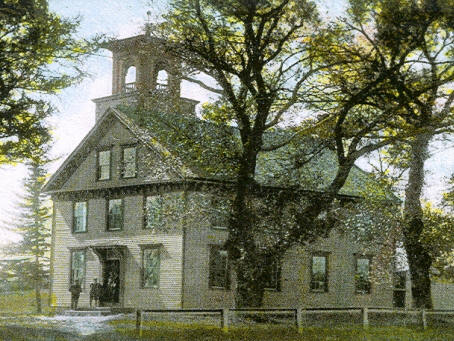 Litchfield Academy
|
|
|
The Academy, incorporated in 1845, adopted an earlier high school opened in 1840 and was held in rooms "fixed up" in the Congregational Meetinghouse at the Corner beginning that fall. It was a private school supported by tuition. In the earliest days this amounted to three dollars for a 12-week term, a figure which had risen to $4.50 by the time the 1864 catalog was printed. Board and room charges "in good families" cost from one to one and a half dollars a week. In the early 1900's Mrs. William R. Godfrey took students as roomers for 50 cents a week and allowed them to bring their own food and prepare it on her stove. "Students would arrive on Sunday nights, each with a big box of provisions to last for the week." In 1849 the legislature gave the school a half-township of land in Aroostook which the trustees sold for $5650, thus supporting the construction of an academy building - the structure which stands today as part of the Libby-Tozier School. The advent of the competing Liberal Institute turned the Corner into a center of learning for the entire area, with some 300 students attending the two schools in that small village where "every house was a boarding house and full to overflowing." In 1864 the Academy had a total enrollment of 107: 69 from Litchfield and the rest from twelve other towns and Boston.
|
The school
offered a wide variety of courses including practical or vocational
studies - bookkeeping, surveying and navigation as well as classical
and college preparatory classes in English, rhetoric, mathematics,
science and philosophy together with French and Latin. Alden
G. Smith, whose grandfather was secretary of the Board of Trustees
in 1879, wrote from Georgia, "If present students complain of the
rigors of the curriculum you can remind them of the tribulations of
their predecessors at the Academy. I know that my father was
well grounded in Greek, Latin, rhetoric and mathematics up to the
calculus and was prepared for college at age 13... In those days it
was considered a privilege to be able to attend school." With the coming of free high schools the town entered into an agreement to pay Academy trustees for four years of schooling of resident pupils, and the school continued, though with dwindling enrollments until 1960. That year the town contracted with larger Monmouth Academy for schooling of all but the ninth (freshman) year for Litchfield young people. Finally in 1966 freshman were also sent to Monmouth and our Academy, after a useful career of over 120 years, ceased to offer senior high school studies. source: Litchfield Yesterdays Photos Of Litchfield Academy Students
|
